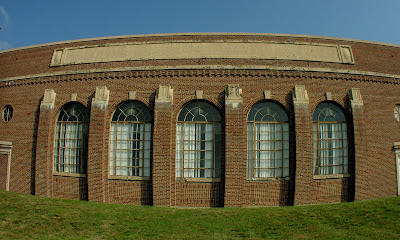My mother, Anne Theresa Summers, was a very good student. Her report card shows that her teachers considered her superior in almost every way (but only above average in cooperation!)
She graduated from Marlboro High School in 1942, one of thirty-seven seniors in the 35th graduating class, a member of the debate team and of the National Honor Society. Her favorite subject, according to her yearbook, was Problems of Democracy. She was the president of the Home Ec Club and was also in the Glee Club and the School Orchestra. She went on to college at George Washington University.
And of course, the senior class had a will. Mom willed her "studious ability and a few of her grades" to Ambrose Baden and Ralph Weaver, apparently young men who were not at the top of the class.
Here is the student body in front of the school in 1942. Mom is in the front row, third from the right, in the very sharp looking vest, which she probably made herself.
What my mother may not have realized when she was a student was that she attended a very historic high school.
Marlboro High School was located on the site of Dr. William Beanes' home. Beanes, as history fans may remember was the prisoner whom Francis Scott went to rescue when he witnessed the shelling of Fort McHenry in the Baltimore harbor. Dr. Beane's home was said to be the finest in Upper Marlboro.
After Dr. Beane's death in 1828, the house was altered to become the Marlborough Academy, established by the legislature in 1835. The subjects taught included Dictionary, Geography, Latin, algebra, Geometry, and Cyphering; Greek and French studies were soon added. Hours were 8:00 a.m.to 5:30 p.m., and September was vacation month. At first only boys were admitted, but by 1840 there were female students as well; a report for 1844 indicates the attendance of 42 boys and 18 girls.
In 1855, the Academy building burned to the ground, but by 1860, the site was known as Academy Hill and housed a new one-and-a-half story school building with a central bell tower. In 1867, after the establishment of the Board of County School Commissioners, a separate public school for girls was established immediately east of the academy building, and the two buildings were separated by a “good and substantial fence.”
Frederick Sasscer (a cousin of mine and later the County's Superintendent of Schools) described the education he received at the Academy after the Civil War:
The Academy building then consisted of two rooms, one of which was the school room and the other the bed room of the professor. . . . His classes, wonderful to tell, ranged from boys learning the alphabet, the first step in education, then to classes in Cicero and Xenophon. . . . The furniture was of the rudest kind. Desks with sloping lids in sets of three, in all about 30, were arranged against the walls. . . . The very small boys, who had no writing to do, found resting places on two long benches with backs. There were no blackboards, no free books and few physical comforts. The old professor sat at a small table in an arm chair, and was always supplied with a goodly number of supple rods, for the rod was not spared in those primitive days.
In 1921, the Academy was replaced by Marlboro High School, built at a cost of $38,000 by Thomas Marsden. It was of masonry construction, coated with white-painted cement, and distinguished by a handsome shaped parapet on its south entrance façade. It had eight classrooms, offices and a library, as well as rooms for manual training and home economics.
In 1934, a Classical-Revival style façade was added to the building, significantly enlarging it. A large red-brick addition including eight more classrooms and an auditorium was built, wrapping around and hiding the south entrance façade of the original 1921 structure.
Marlboro High School operated until 1948, when classes were moved to the Frederick Sasscer High School to address overcrowding. The building continued to house primary and middle school classes until 1974. After that it functioned as office space for various county agencies.







No comments:
Post a Comment